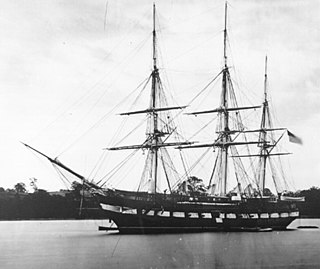Sloop
sail boat with a single mast and a fore-and-aft rig From Wikipedia, the free encyclopedia
Remove ads
A sloop is a sailboat usually with one mast and fore-and-aft rigged sails.[1] It can also describe a square rigged sailing ship of two or more masts which is sometimes called a sloop of war.[1] The French called them corvettes.[2] Originally the definition of a sloop was vague. A 1750 book said sloops "are sailed and masted as men's fancies lead them, sometimes with one mast, with two, and with three."[2] Modern recreational sloops are almost always one-masted sailing ships with fore-and-aft sails.[3] Their simple layout makes them popular with amateur sailors.[3] The sloop is a manageable sailboat layout up to a length of about 45 feet (14 m).[3]

A sloop on the Potomac River in Maryland in 2003
Remove ads
History
The sloop design dates back to the early part of the 17th century.[3] By the 20th century they became very popular. Their main advantages are their ease of handling and ability to sail upwind (into the wind).[3]
An early 17th century design was the Bermuda sloop, so-named for the Bermuda trade with North America.[4] It was designed to be fast and could sail in both directions.[4] They needed to be fast to outrun French privateers. The hull was made from Bermuda cedar.[4] The wood was light and resisted rot.[4] They had from one to three masts.[4]

Gaff-rigged sloop
Most modern sailboats are based on the Bermuda sloop design.[4] The Bermuda rig replaced the earlier gaff rig which used a four-cornered sail (instead of a triangular sail) and a spar.[5] A gaff rig design allows more sail on a mast. Another advantage is the gaff rig and other early designs can spill wind faster in a blow (heavy wind).[5]
The sloop of war was the most numerous design in the Royal Navy by the end of the Napoleonic Wars.[6] Yet very little has been written about them or their French counterpart, the Corvettes.[6] Later, the United States used sloops of war.[6] The Royal Navy used the class of "sloop" right up until the end of World War II.[6] The sailing sloop, like its larger cousin the frigate, were fast and used in a variety of roles.[6] They were not usually used in battle, but were more often used for support in reconnaissance and for carrying messages.[6] They were probably the best of the Royal Navy sailing ships for maneuverability and could function in all but the roughest sea conditions.[6]
Remove ads
Related pages

USS Constellation (1854) a U.S. sloop-of-war; the last sailing warship in US Navy
- Frigate
- Schooner
- Brig
- Brigantine
- Cutter (boat)
- J-class yacht
- Lugger
- Keelboat
- Yacht
- Skerry cruiser
- Smack (ship)
- Yawl
- Thames sailing barge
- Pocket cruiser
Reference
Other websites
Wikiwand - on
Seamless Wikipedia browsing. On steroids.
Remove ads
